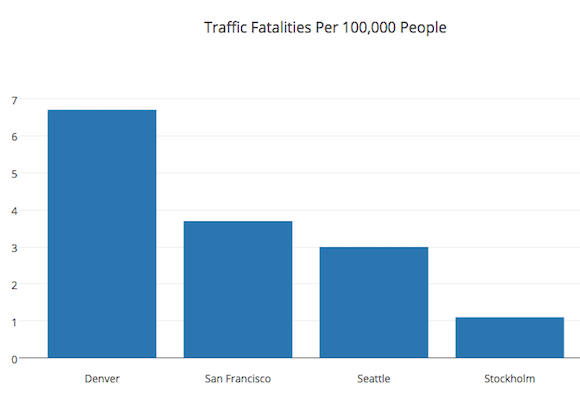Why Denver Needs to Get Serious About Street Safety and Adopt Vision Zero

Traffic deaths are not an inevitable fixture of modern life, but preventable tragedies that can be systematically eliminated by smart public policy. That’s the thinking behind Vision Zero, an increasingly influential approach to street safety in cities around the world. Now is the ideal time for Denver’s leaders to join in.
Vision Zero has its origins in Sweden, where the national government took a more urgent approach to the reduction of traffic deaths and serious injuries starting in the late 1990s. The people who design the nation’s transportation systems now treat the prevention of fatal crashes as a moral imperative, and they set policy accordingly. Today, Sweden’s traffic fatality rate is among the lowest in the world, and the Vision Zero concept has spread to American cities, including Seattle, Portland, and New York, to name a few.
The Vision Zero approach recognizes that people make mistakes, and, primarily through engineering and enforcement, designs streets and transportation systems where human error does not result in fatal consequences. A primary focus in urban areas is reducing maximum vehicle speeds, which put everyone at risk, but especially pedestrians and people on bikes. By making the streets safe for walking and biking, the system will be safe for people in cars and trucks too.
Between 2012 and 2014, 49 pedestrians were killed in crashes on Denver’s streets. Seven more have been killed so far this year, including 3-year-old Austin Strasser. For mourning friends and family members, that’s seven deaths too many. Over the same three-year period, six people on bikes have been killed — five of them last year.
Denver Mayor Michael Hancock has yet to make a commitment to Vision Zero goals, while peers like New York’s Bill de Blasio and Seattle’s Ed Murray stake out ambitious street safety targets. And Denver’s Department of Public Works has no specific plan to eliminate traffic deaths and serious injuries, though transportation officials told Streetsblog they take safety seriously.
“Safety is our number one goal, even if we have not officially said Vision Zero is our thing,” said Director of Transportation Crissy Fanganello.
DPW spokeswoman Nancy Kuhn pointed to the Colorado Center Bicycle and Pedestrian Bridge and $2 million worth of signal improvements on East Colfax as examples of safety projects. Projects like these are steps in the right direction, but they aren’t bold enough to move the needle on traffic deaths.
Cities that are getting serious about reducing fatal crashes are rethinking their biggest streets with major redesigns — “road diets” that reduce speeding by narrowing traffic lanes, protected bike lane designs that reallocate space from motor vehicle traffic to two-wheeled travel, and the addition of sidewalk space and pedestrian islands to make streets safe enough for the elderly or disabled to cross without fearing for their lives.


A better example cited in the materials from Kuhn is the potential transformation of 19th and 20th Avenues [PDF] into two-way streets. Converting one-ways is proven to calm speeding traffic and enhance street safety for everyone. But there is only one such conversion on the city’s radar right now.
Despite the advent of the Mayor’s Pedestrian Advisory Committee, advocates say some planned projects will actually take the city backward on street safety.
“We’re hopeful that with the input of the newly established committee, the city will start embracing strategies that more directly address pedestrian safety, particularly in low-income neighborhoods that tend to have the highest pedestrian fatality rates,” said Jill Locantore, policy director with pedestrian advocacy group WalkDenver. “We’re disappointed, however, that the city is continuing to prioritize automobile traffic by widening roadways, such as Broadway near I-25.”
More curb extensions to slow down drivers before turning corners, Locantore said, would be ideal.
Without a coherent citywide plan, with well-defined benchmarks that can be used to assess performance over time, any progress is likely to be uneven at best. A DPW traffic engineer told me the department prioritizes improvements in areas where changes can be implemented easily. That means the most dangerous streets aren’t necessarily the most likely to get improved.
In Denver’s strong-mayor form of government, leadership from Mayor Hancock will be essential if the city is going to rapidly improve the safety of its streets. So far, Hancock has committed to governing with a complete streets approach but has yet to announce exactly what that will look like on the ground. Vision Zero could be the concept that gives more shape and specificity to Hancock’s promise.
Data sources for chart: Seattle DOT, Seattle mayor’s office, Colorado DOT, SF Bicycle Coalition, NHTSA


